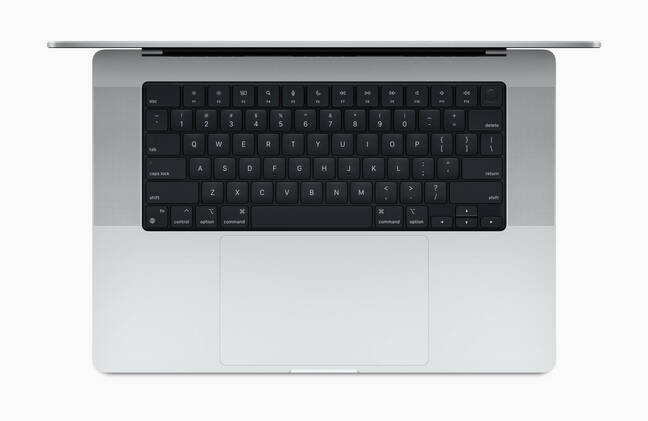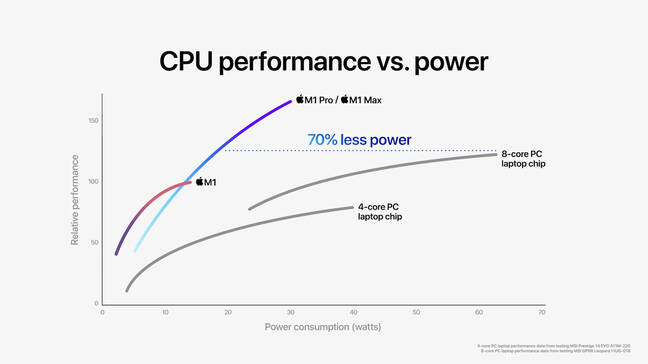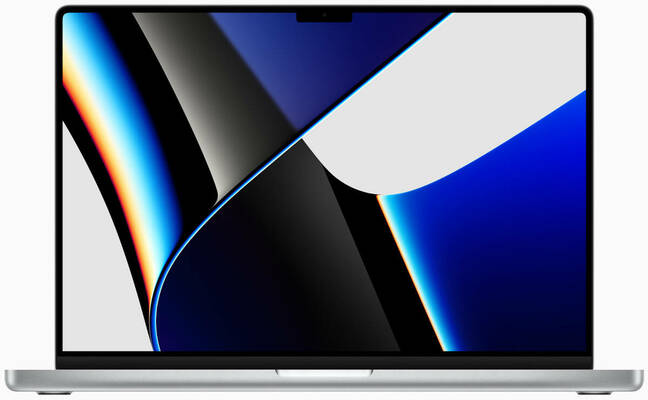This article is more than 1 year old
Apple arms high-end MacBook Pro notebooks with M1 Pro, M1 Max processors
x86 is an eighty-sixed ex
Apple on Monday announced 14- and 16-inch MacBook Pro models armed with Arm-compatible Apple Silicon chips, extending its platform architecture transition, and Intel exodus, for its high-end notebooks.
Cupertino's web-streamed presentation, which also featured new music products and services, was highly anticipated by Apple customers because, as expected, it addressed long-standing complaints about recent MacBook Pro models. In particular, their failure-prone keyboard, the unasked-for TouchBar, and the finicky USB-C power connector.
Though Apple's disastrous Butterfly-design keyboard has already been dealt with, the first aspect of the new MacBook Pro models that product manager Shruti Haldea discussed was the keyboard.
"The new MacBook Pro has been reimagined in every way," said Haldea during the streaming video presentation. "Let's start with the keyboard. Users value the full height function row on the standalone Magic Keyboard, And we brought it to the MacBook Pro. The physical keys replace the TouchBar, bringing back the familiar tactile feel of mechanical keys that Pro users love."
But that reassurance took a back seat to Apple's execs crowing about the company's artisanal silicon. The new MacBook Pro models bring new chips: the M1 Pro and the M1 Max, Apple's followup to the Apple Silicon M1 chip that debuted last year.
"Building a pro laptop has meant using a power-hungry CPU and discrete GPU," said Johny Srouji, SVP of hardware technologies at Apple. "But a two-chip architecture requires more power and cooling. It also means the CPU and GPU have separate pools of memory, so they have to copy data back and forth over a slow interface.
"No-one has ever applied a system-on-a-chip design to a pro system, until today. And we did this by scaling up M1's groundbreaking architecture to create a far more powerful chip with M1 Pro."
The M1 Pro relies on 5nm process technology. It sports 33.7bn transistors – twice as many as the M1. The chip has a 10-core CPU – eight high-performance cores and two high efficiency cores. Apple claims it's up to 70 per cent faster than M1, depending on the workload, delivers up to 1.7x better CPU performance than the latest 8-core PC laptop chip when using comparable amounts of power, and at equal performance levels uses 70 per cent less power than the PC chip.
The M1 Pro has an up-to-16 core GPU that's said to be twice as fast as the M1 and 7x faster than an 8-core PC with integrated graphics. It's available with up to up to 32GB of memory and up to 200GB/s of memory bandwidth.
The M1 Max is what you get when you take the M1 Pro's 10-core CPU and double its GPU cores to 32. The result is 4x better GPU performance and the original M1, which debuted last year. Built with 57bn transistors, it supports up to 64GB of memory – compare that to the 16GB of video memory commonly available to PC laptops – and offers 400GB/s of memory bandwidth.
Apple claims the 14-inch model gets 17 hours of video playback while the 16-inch model gets 21 hours – 10 more than on prior Mac notebooks.
The other gubbins
The M1 Max also has an enhanced media engine capable of editing up to 30 4K ProRes video streams or up to seven 8K ProRes video streams in Final Cut Pro. The M1 Pro supports up to two Pro Display XDRs (Apple's $5K monitor) while the M1 Max can handle up to three ProDisplay XDRs and a 4K TV at once.
Both the 14- and 16-inch MacBook Pro models come with macOS Monterey, three Thunderbolt 4 ports, an SDXC card slot, an HDMI port, and a 3.5mm headphone jack. Apple's magnetic power connection system MagSafe has returned, under the name MagSafe 3.
Both models sport a Liquid Retina XDR display, complete with an iPhone-like notch that houses a webcam and surprisingly doesn't have a Face ID sensor, plus a built-in anodized black Magic Keyboard.
They have two fans for chip chilling, unlike the fanless M1-based MacBook Air, though Cupertino claims Apple Silicon is so efficient most users will never hear them.
"With this introduction, we've taken another huge step forward in the Mac's transition to Apple Silicon," said John Ternus, VP of hardware engineering at Apple.
- Apple's M1 MacBook screens are stunning – stunningly fragile and defective, that is, lawsuits allege
- Apple warns of arbitrary code execution zero-day being actively exploited on Macs
- The M in M1 is for moans: How do you turn a new MacBook Pro into a desktop workhorse?
- Microsoft's axeman cometh for OneDrive sync app on older versions of macOS
Apple did not respond to a request to say whether the M1 Pro and M1 Max resolve the M1RACLES oversight reported for the M1 chip in May, 2021, and a reported second blunder identified over the weekend.
In a message to The Register, Hector Martin, founder and project lead of Ashai Linux and the finder of the initial M1 flaw and of the supposed second one, said Apple cannot address the M1 design error except through new silicon. He said he didn't know whether Apple has done so in the M1 Pro and M1 Max. And he declined to provide further details about his second alleged bug, which has not yet been publicly disclosed.
Apple also announced its third-generation AirPods, "new bold and expressive colors" for its Home Pod mini mic-speaker thingy, the Apple Music Voice Plan (a $4.99 Siri-focused starter plan for Apple Music), and updates to Final Cut Pro and Logic Pro so that they can take advantage of Apple's latest chips.
Apple is now taking orders for the new 14- and 16-inch MacBook Pro models and they're expected to be available on Tuesday, October 26, or sometime thereafter if customized with more memory and SSD storage. The 14-inch MacBook Pro model starts at $1,999, and $1,849 for education customers. The 16-inch MacBook Pro model starts at $2,499, and $2,299 for the student market. ®




